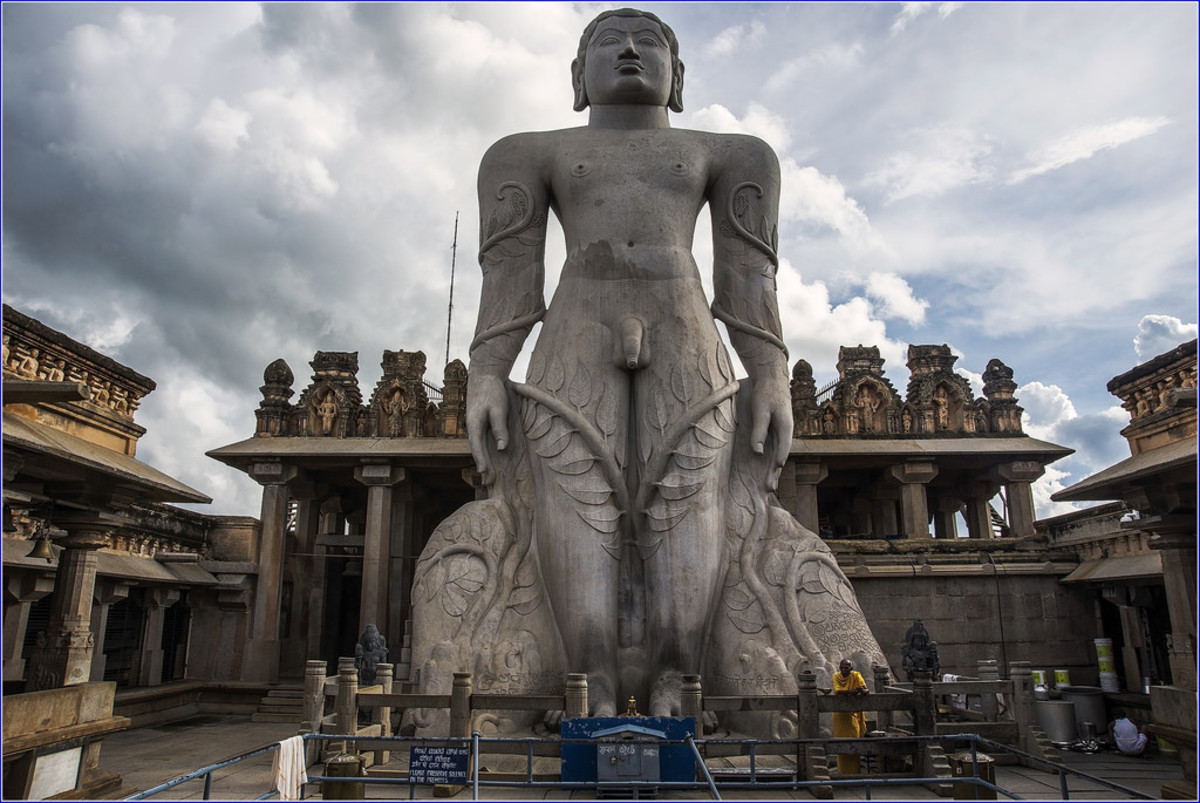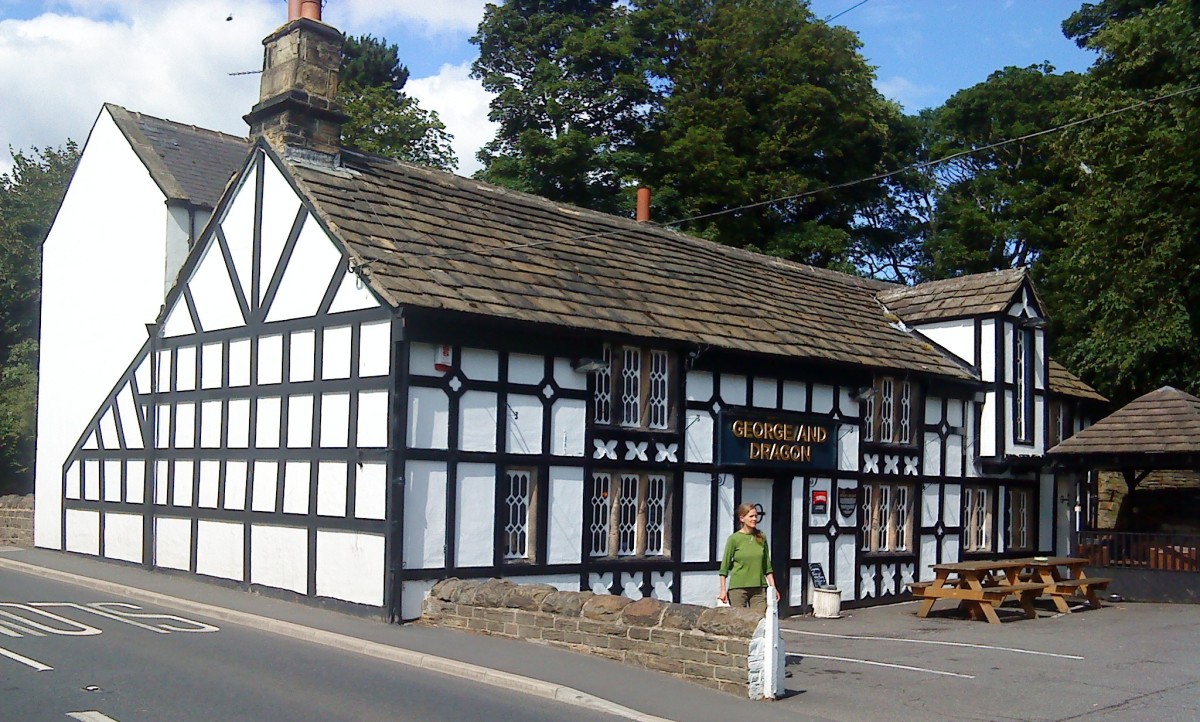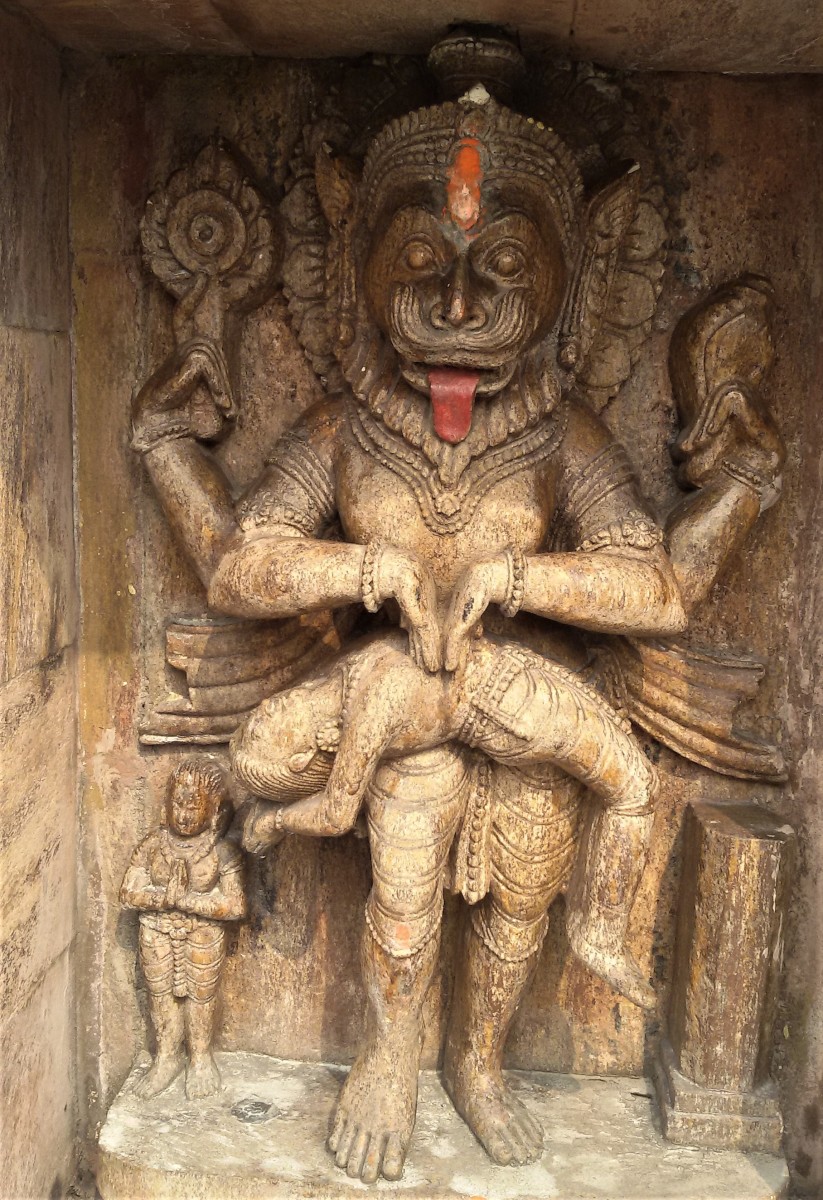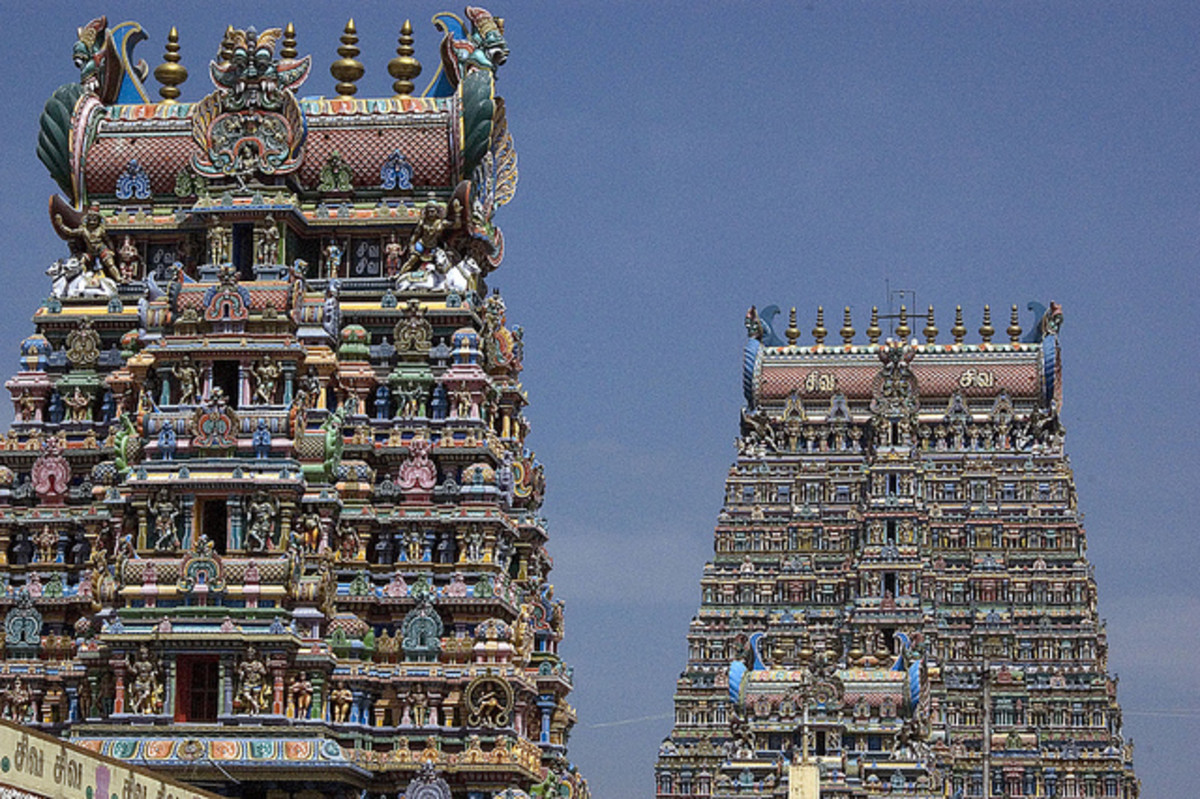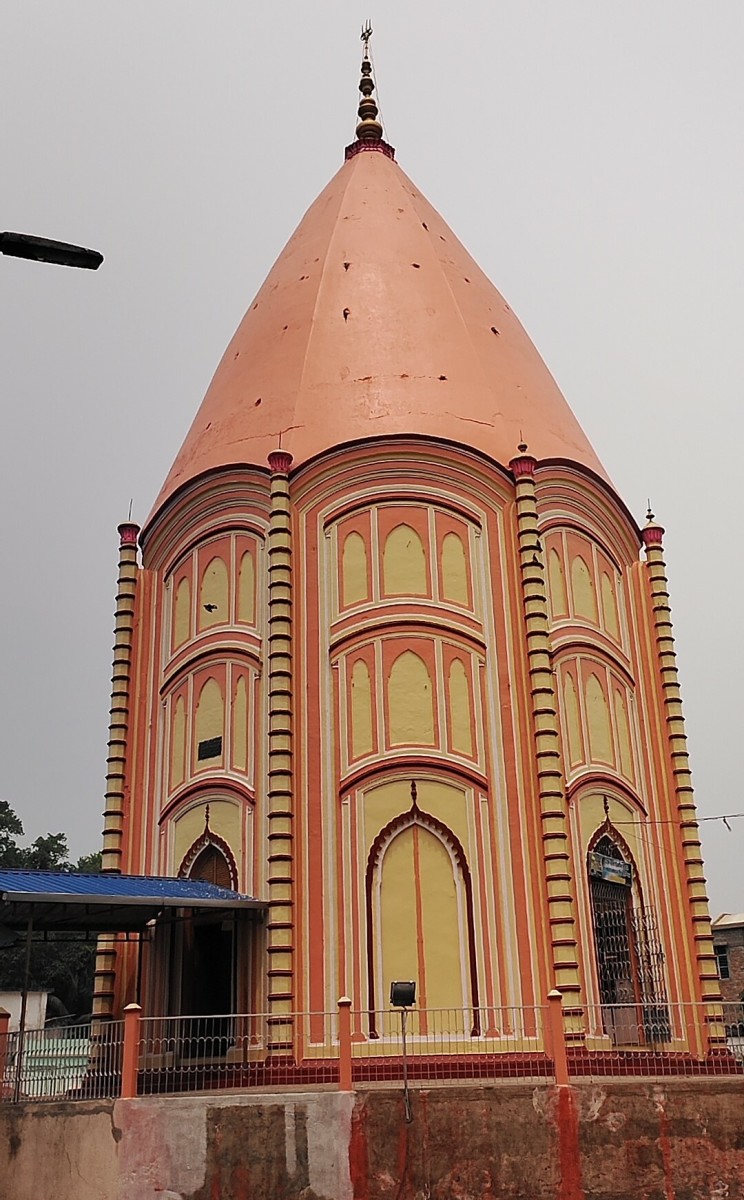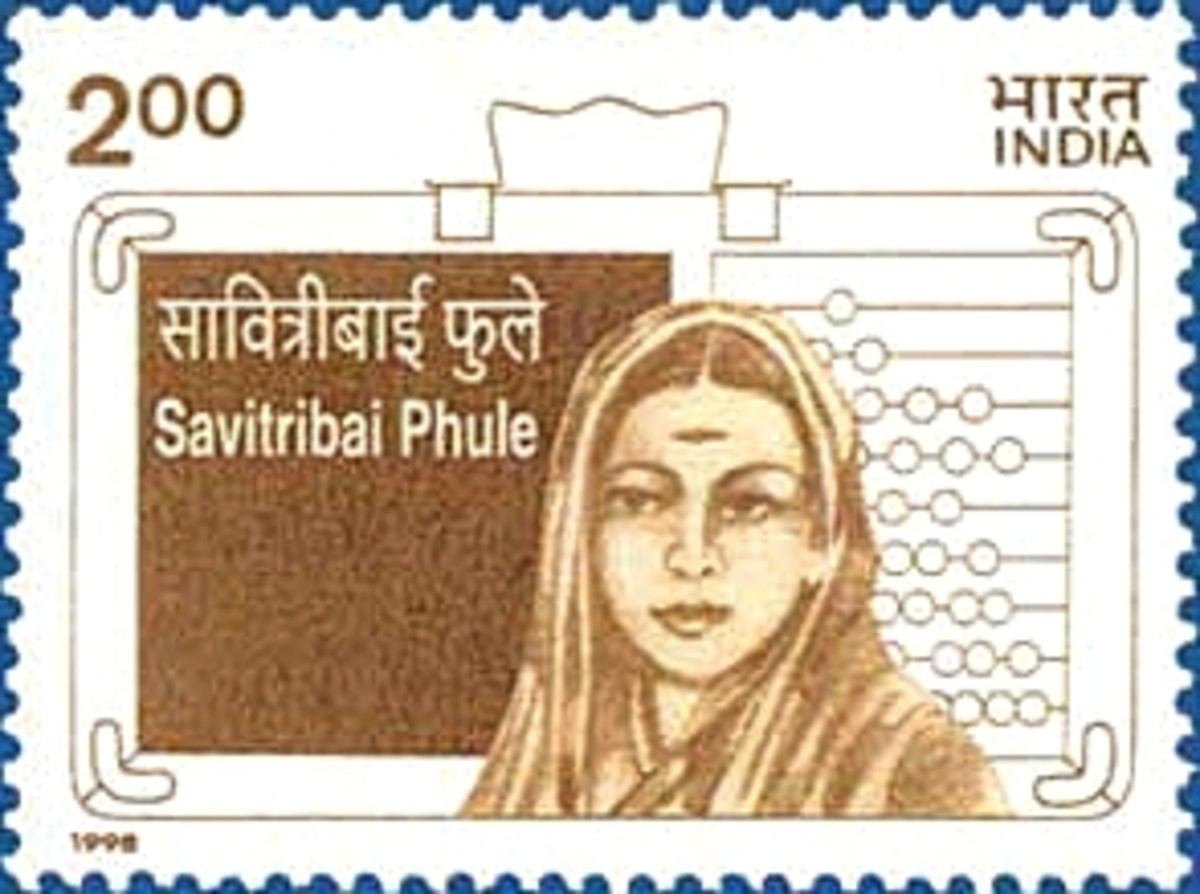- HubPages»
- Education and Science»
- History & Archaeology»
- History of Asia
Temples in India-A symbol of Indian culture
Kashi Vishwanath Temple
Location: Varansi
State: Uttar Pradesh
Principle Deity: Lord Shiva (Vishwanath)
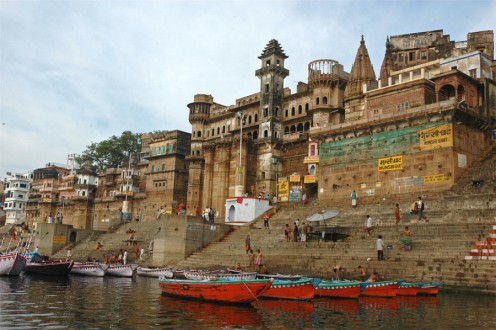
The Kashi Vishwanath temple is located in the heart of the cultural capital of India, Varanasi. It stands on the western bank of India's holiest river Ganges. The Kashi Vishwanath temple is the center of faith for millions of Hindus. The Jyotirlinga of Shiva, Vishweshwara or Vishwanatha, is enshrined in the Kashi Vishwanath temple, considered as one of the holiest temples of India. In Hindu religion it is believed that a simple glimpse of the Jyotirlinga is a soul-cleansing experience that transforms life and puts it on the path of knowledge and Bhakti (devotion). A single darshan of Vishweshwara Jyotirlinga is considered to merit more than the darshan of other jyotirlingas, scattered in various parts of India. The Kashi Vishwanath Temple has been a living picture of the timeless cultural traditions and highest spiritual values. The Kashi Vishwanath Temple attracts Hindu devotees and other visitors not only from India but also the world over. Lord Vishwanath is considered the supreme repository of the spiritual truth and strengthens the bonds of universal brotherhood. Late Maharani Ahilya Bai Holkar of Indore built the temple in the present shape, way back in 1780. In the year 1785, a Naubatkhana was built up in front of the Temple at the instance of Governor General, Warren Hastings. In 1839, two domes of the Temple were covered by gold, donated by Maharaja Ranjeet Singh, the ruler of Punjab. The management of the Kashi Vishwanath temple rests with a trust.
The Vishwanath temple opens daily at 2.30 A.M. for Mangala Aarti and between 3 to 4 A.M. ticket holders are permitted to join. The timing of general Darshan is from 4 to 11 A.M. The timing for midday Bhog Aarti is from11.30 to 12 A.M. Between 12 noon to 7 P.M., general devotees are free to have Darshan. From 7 to 8.30 P.M. the Sapta Rishi Aarati is held after which Darshan is possible again till 9 P.M. At 9 P.M. the Shringar/Bhog Aarati starts and after that Darshan is possible only from outside. Shayana Aarti starts at 10.30 P.M. and the temple closes at 11 P.M. Most of the offerings at the Kashi Vishwanath temple are given to poor.
Puri Jagannath Temple
Location:puri
State:Orissa
Principle Deity: Lord Jagannath(Lord Sri Krishna)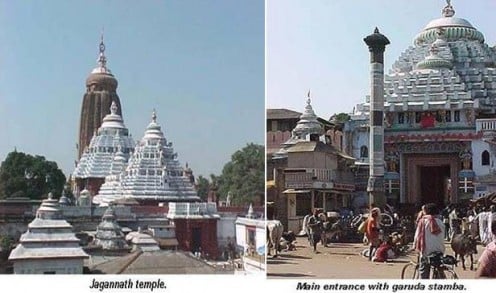
The celebrated Temple of Lord Jagannath now existent at Puri was constructed by Raja Ananta Varman Chodaganga Dev in 12th century A.D. The wooden images of Jagannath Balabhadra and Subhadra were installed in that temple. The management of the temple continued under the Hindu rulers till 1558, when the State of Orissa was conquered by the Afghan Nawab of Bengal and the temple was attacked by the Afgan General ‘Kalapahad’. Then, an independent Khurda kingdom was established by Ramachandra Deb, who assumed the management of the temple. He consecrated the temple and reinstalled the deities. Raja Mansingh, a General of the Mughal King Akbar, defeated the Afghans and annexed Orissa in to the Mughal dominion. It remained under the Mughals till 1751 A.D. Till 1760, the temple continued under the Khurda Raja, who was paying tribute to Mughals and Marhattas. Marhattas took up direct management of the temple till 1803. The Britishers annexed Orissa into British empire in 1803 and allowed Puri Raja to manage the temple. The position continued till 1947.
Konark Sun Temple
Location:puri
State:Orissa
Principle Deity: Surya (Sun god)
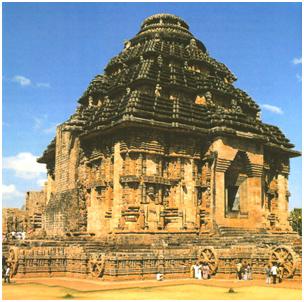
Konark is one of the well known tourist attractions of Orissa. Konark, Konark houses a colossal temple dedicated to the Sun God. Even in its ruined state it is a magnificient temple reflecting the genius of the architects that envisioned and built it. Bhubaneshwar, Konark and Puri constitute the Golden triangle of Orissa, visited in large numbers by pilgrims and tourists.
Konark is also known as Konaditya. The name Konark is derived form the words Kona - Corner and Arka - Sun; it is situated on the north eastern corner of Puri or the Chakrakshetra. Konark is also known as Arkakshetra.
This temple built in 1278 CE by the Ganga King Narasimha Deva is one of the grandest temples of India and was referred to as the Black Pagoda. The ruins of this temple were excavated in late 19th century. The tower over the Garbagriha is missing, however the Jagmohana is intact, and even in this state, it is awe inspiring.
Legend has it that Samba, the king of Krishna and Jambavati entered the bathing chamber of Krishna's wifes, and was cursed by Krishna with leprosy. It was decreed that he would be relieved of the curse by worshipping the sun God on the sea coast north east of Puri. Accordingly Samba reached Konaditya Kshetra and discovered an image of Surya seated on the lotus, worshipped him and was relieved of his curse.
It is said that the temple was not completed as conceived because the foundation was not strong enough to bear the weight of the heavy dome. Local beleif has it that it was constructed in entirety, however its magnetic dome caused ships to crash near the seashore, and that the dome was removed and destroyed and that the image of the Sun God was taken to Puri.
The Temple: The Konark temple is widely known not only for its architectural grandeur but also for the intricacy and profusion of sculptural work. The entire temple has been conceived as a chariot of the sun god with 24 wheels, each about 10 feet in diameter, with a set of spokes and elaborate carvings. Seven horses drag the temple. Two lions guard the entrance, crushing elephants. A flight of steps lead to the main entrance.
Akshardham Temple
Location: New Delhi
State: Delhi
Principle Deity: Various Hindu Gods and Goddesses
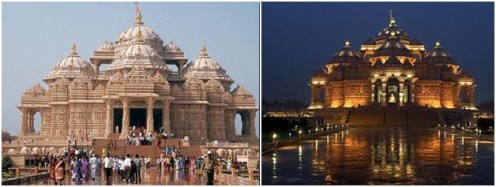
Akshardham Temple in Delhi has an important place in Delhi’s tourism. The structure depicts great Indian culture and its architecture is simply immaculate. The temple is located at NH 24, Noida Mor, New Delhi. This amazing structure comprises of 20,000 statues, floral motifs and exquisite carved pillars made of stones.
This beautiful structure and masterpiece architecture was built under the support and funding of the Bochasanvasi Aksharpurushottam Swaminarayan Sanstha (BAPS). The temple was inaugurated on November 7, 2005 by Pramukhswami Maharaj (Leader of BAPS).
It is built along the river Yamuna and lies over an area of around 100 acres with beautiful gardens, water fountains and carved pavilions. The temple took complete two years for completion and a hefty sum of rupees was invested in the construction. According to estimates, around 2 billion was spent in the construction of this masterpiece which indeed depicts the great Hindu religion.
The architecture of Akshardham temple is similar to the one at Gandhinagar in Gujarat. The main monument at the temple is about 141 feet high with a beautiful statue of Lord Swaminarayan. There are various structures within the temple which depicts the history and culture of Hindu Religion.
Dilwara Temple
Location: Mount Abu
State: Rajasthan
Principle Deity: Jain Thirthankar
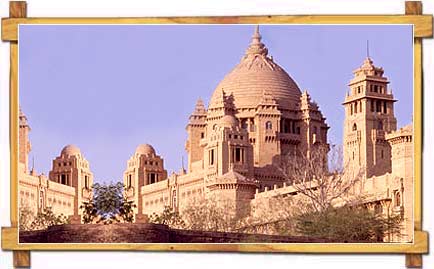
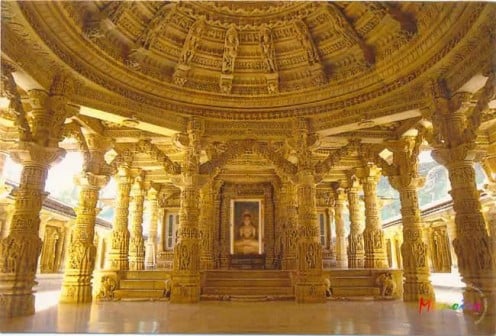
The Jain Dilwara temples of India are located about 2½ kilometers from Mount Abu, Rajasthan's only hill station. These temples dating back from the 11th to the 13th century AD are world famous for their stunning use of marble. The five legendary marble temples of Dilwara are the sacred pilgrimage of the Jains. They are an overwhelming blend of simple beauty and exquisite elegance. The marble temples have an opulent entranceway. The simplicity in architecture verily reminds one that Jainism as a religion "encouraged honesty and frugality". The temples reside amidst mesmerizing surroundings of mango trees and wooded hills. A high wall, shimmering luminous in the sunlight, shrouds the temple complex.
Although the Jains built some beautiful temples at other places in Rajasthan but none come close to these in terms of architectural perfection. The ornamental detail spread over the minutely carved ceilings, doorways, pillars and panels is simply marvellous and has to be seen to be believed.
Five Unique Temples of Dilwara There are 5 temples in all, each with its own unique identity though together they are named after the small village in which they are located. These are:
Vimal Vasahi (Shri Adi Nathji temple)
Luna Vasahi (Shri Nemi Nathji temple)
Pithalhar (Shri Rishabh Deoji temple)
Khartar Vasahi(Shri Parshav Nathji temple)
Mahaveer Swami (Shri Mahaveer Swamiji temple)
The most famous of these are the Vimal Vasahi and Luna Vasahi temple.
Golden Temple
Location: Amritsar
State: Punjab
Principle Deity: Harmandar Sahib(Temple Of God)
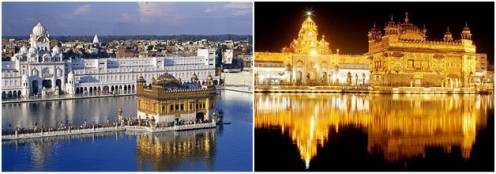
The Golden Temple stands as one of the most visited tourist attractions in the city of Amritsar. On your tour to India you will thoroughly like your visit to the city of Amritsar as it offers itself as a religious as well as a major tourist site. One of the several tourist attractions in Amritsar, the Golden Temple is visited by several travelers from various parts of the world. The Golden Temple history is one of the several areas that the tourists would love to explore. Believed to have been built in 1588 by Guru Arjan Dev with a view to create a central site of worship for the Sikhs, the Golden Temple or Harmandir as it is called, symbolizes the philosophy of the religion through every detail of its architecture. The location of the temple amid a pool, which was conceptualized by Guru Amar Dev, denotes the synthesis of nirgun and sargun - the spiritual and temporal realms of human existence.Although Guru Arjan Dev was instrumental in laying the foundation of the Gurudwara, the Golden Temple history says that its construction has been the result of several years’ evolution.
Even before the main shrine of the Gurudwara was laid, the pool had already been bordered with bricks under the supervision of Baba Budha ji. Guru Arjan Dev, with the principle intention of propagating the ethos of Sikhism, built the structure in sheer burnt brick and lime. Much later, during Maharajah Ranjit Singh’s reign (1799-1839), the temple was renovated and made into an architectural masterpiece, displaying a major sense of affluence along with, of course, the deep spirituality of the Sikh religion.
The history of Golden Temple says that the land for the site was acquired free of charge from the zamindars (landlords) of local villages. Exhibiting influences of both Hindu and Muslim styles of design, the Golden Temple architecture significantly flaunts a large dome of gold.
Positioned in the center of the city of Amritsar, the 40.5 square feet Golden Temple balances itself on a 67 square feet platform. The bridge escorting you to the temple is linked with the 13 feet broad ‘Pardakshna’ or circumambulatory path. Winding around the main temple it reaches the ‘Har ki Paure’ (steps of God). On the first floor of ‘Har ki Paure’, there is a continuous reading session of Guru Granth Sahib. Guru Arjan Dev planned and executed the compilation of the Sikh scriptures: a collection of the teachings, thoughts, hymns, and verses of the first five gurus of the Sikhs, and scholars and saints of Hindu and Muslim like Kabir, Namdev, Ravidas, and Sheikh Farid.
ISKON Temples
Location: Various locations in India
Principle Deity: Lord sri Krishna
A.C. Bhaktivedanta Swami Prabhupada is the founder acharya of the hare krishna movement. Completed in 1998, this is a complex of temples. The International Society for Krishna Consciousness (ISKCON) was initially raised as a spiritual society in New York to Propagate the message of the Bhagwad Gita. It was founded by Swami Prabhupada. In India there are about 40 ISKCON temples. Contemplating the traditions of the ancient Vaishnava tradition, its philosophy and practice, these spiritual temples have left a mark on all mankind. Visiting these temples proves to be a pleasant and revealing experience.
ISKCON temples are dedicated to Lord Krishna and were built by the Hare-Rama Hare-Krishna cult followers. These complexes are elegantly built and are few of the largest temple complexes in India. There are beautiful paintings of Russian artists on the different past times of Radha Krishna, Sita, Ram, Laxman, Hanuman and Chaitanya Mahaprabhu. Special programmes like Kirtan, Aarti, Pravachan and Prasadam are held every Sunday.
Famous ISKCON Temples In India :
ISKCON Temple, Delhi For many this is just a temple, for finding solace, peace and quiet. Sitting amongst Lord Krishna and his devotees with Hare Krishna chants going around is indeed an experience. But for those who are seeking more, there is so much to learn and see, than what meets the eye.
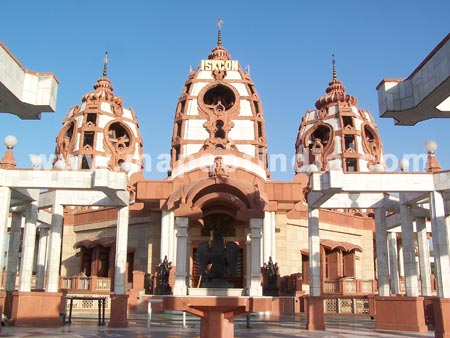
ISKCON Temple, Bangalore, Karnataka The ISKCON Temple was built recently by the International Society for Krishna Consciousness. As you climb the granite steps you will encounter three small shrines before the main temple. The three idols of Lord Krishna in the main shrine are made of brass.
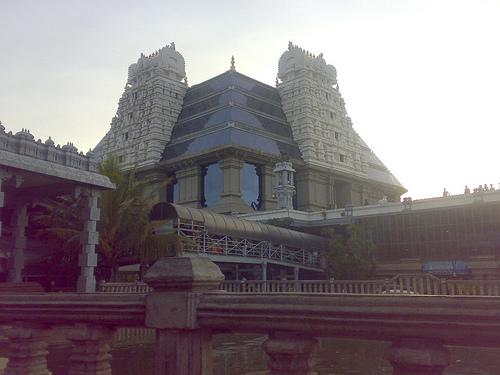
ISKCON Temple, Vrindavan, Uttar Pradesh It is located within the premises of the Krishna-Baldev Temple in Vrindavan. Beautiful paintings depicting the life of Lord Krishna adorn the galleries leading to the main temple. ISKCON devotees from various parts of the world can be spotted manning the library or ISKCON book stalls and partaking in temple rituals.
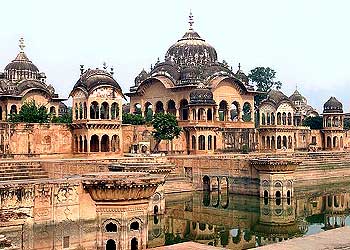
ISKCON Chandradoya Mandir, Mayapur, West Bengal This is the international headquarters of ISKCON. Surrounded by: a Vedic city, the main Deities are Sri Radha Madhava. The Deities are larger than life-size. There are also eight Gopis, four on each side of Radha-Madhava. Also on the main altar is a small set of Radha-Krishna Deities. On the left altar are Deities of the "Pancha-Tattva-Advaita Acarya", Lord Nityananda, Lord Chaitanya, Gadadhara, and Srivasa Thakur. To the left of this altar is another altar with an impressive Deity of Lord Narasimha.
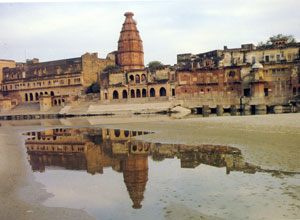
Khajuraho Temples
Location: Khajuraho,Chatarpur district
State: Madhya Pradesh
Principle Deity: medieval Hindu and Jain Gods and Goddesses
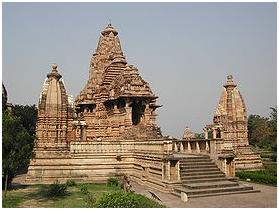
The city was once the original capital of the Chandela Rajputs, a Hindu dynasty that ruled this part of India from the 10th to the 12th centuries. The Khajuraho temples were built over a span of a hundred years, from 950 to 1050. The Chandela capital was moved to Mahoba after this time, but Khajuraho continued to flourish for some time.'
The whole area was enclosed by a wall with eight gates, each flanked by two golden palm trees. There were originally over 80 Hindu temples, of which only 22 now stand in a reasonable state of preservation, scattered over an area of about 8 square miles (21 km²).
Unlike other cultural centers of North India, the temples of Khajuraho never underwent massive destruction by early Muslim invaders between c. 1100-1400 AD. Due to overgrowth following their abandonment, a number of them survived to be discovered by the British in the 19th century. Today, the temples serve as fine examples of Indian architectural styles that have gained popularity due to their explicit depiction of the traditional way of sexual life during medieval times. They were rediscovered during the late 19th century and the jungles had taken a toll on all of the monuments.
The Khajuraho temples, constructed with spiral superstructures, adhere to a northern Indian shikhara temple style and often to a Panchayatana plan or layout. A few of the temples are dedicated to the Jain pantheon and the rest to Hindu deities - to God's Trio, Brahma, Vishnu and Shiva, and various Devi forms, such as the Devi Jagadambi temple. A Panchayatana temple had four subordinate shrines on four corners and the main shrine in the center of the podium, which comprises their base. The temples are grouped into three geographical divisions: western, eastern and southern.
With a graded rise secondary shikharas (spires) cluster to create an appropriate base for the main shikhara over the sanctum. Kandariya Mahadeva, one of the most accomplished temples of the Western group, comprises eighty-four shikharas, the main being 116 feet from the ground level.
Somnath Temple
Location: Prabhas Kshetra, Saurashtra
State: Gujarat
Principle Deity: Lord Shiva
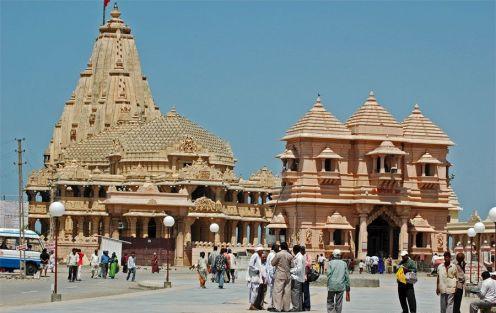
The temple of Somnath, one of the 12 Jyotirlingas of Lord Shiva is situated 79 Kms. from Junagadh and 25 Kms. from Chorwad. According to the legend, Somnath is as old as creation, built by none other than the Moon God himself. The remains of the temple of Somanath "withstood the shocks of time and survived the attacks of destroyers. The temple has imposing architecture and is a beautiful sight facing the blue expanse of the Arabian Sea. A short distance from the Somnath temple is Bakhla Tirth, where Lord Krishna was said to have been struck by the stray arrow of a Bhil tribal. The Present Temple, Kailash Mahameru Prasada is built in the chalukya style of temple architecture and reflects the inherent skill of Sompuras, Gujarat's master masons.
Soma is the name for the moon, the son in-law of Daksha. Once Soma disobeyed a certain instruction of his father-in-law. Daksha was so angry that he cursed him, saying, "Thou shalt wane!" The moon, who used to shine in full splendor every night till then, started to shrink. However, before the curse brought about an absolute end to the moon, many a god requested Daksha to revoke his curse. Daksha asked Soma to take a bath in the sea at the mouth of the river Saraswati and then to pray to Lord Shiva. Hence at Prabhasa, Shiva came to be known as Somanath, the Lord of the moon.
It is believed that the Somnath temple here was originally built by Somraj, the Moon God himself, out of gold, and then rebuilt by Ravana in silver and then by Krishna in Wood, then by Bhimdev in stone. Somnath is also known by several other names -- Deo pattan, Prabhas Pattan or Pattan Somnath, which it acquired during its long and eventful history. Somnath was once the most revered shrine in the country, for it had one of the twelve pre-eminent Jyotirlingas (the glowing Lingas), which held a special significance for the Hindus. Somnath's glory and fame are legendary. It is said that people from the remotest parts of the country came to worship at the shrine; revenues collected from ten thousand villages was spent on the maintenance of the temple. Two thousand Brahmins (priests) served the idol and a golden chain attached to a huge bell plate announced the commencement of prayers.
Madurai Meenakshi Temple
Location: Madurai
State: TamilNadu
Principle Deity: Goddess Meenakshi
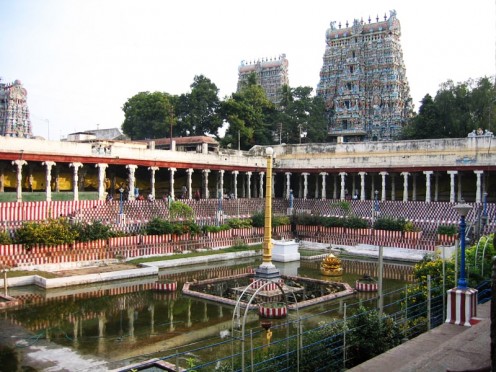
The Meenakshi Sundareswarar Temple or Meenakshi Amman Temple is a historic Hindu temple located in the holy city of Madurai, Tamil Nadu, India. It is dedicated toLord Shiva (in the form of Sundareswarar or Beautiful Lord) and his consort, Goddess Parvati (in the form of Minakshi). The temple forms the heart and lifeline of the 2500 year old city of Madurai, home of the Tamil language.
The temple has a stunning architecture and a significant testimony for Vishwakarma Brahmins for their master architecture in sculpting this temple. This was a frontrunner in the election for the modern seven wonders of the world for its architectural importance. The complex houses 12 magnificent gopurams or towers that are elaborately sculptured and painted. The temple is a significant symbol for the Tamil people, and has been mentioned since antiquity in Tamil literature, though the present structure is believed to have been built only recently in the early 17th century.
According to Hindu legend, Shiva came down to earth in the form of Sundareswarar to marry Meenakshi, an incarnation of Parvati. Parvati had earlier descended to earth in the form of a small child in response to the great penance of Malayadwaja Pandya, the ruler of Madurai.After growing up to adulthood, she began ruling the city. The Lord appeared on earth and proposed to her. The marriage was supposed to be the biggest event on earth, with the whole earth gathering near Madurai. Vishnu, the brother of Minakshi, was traveling to preside over the marriage from his holy abode at Vaikuntam. Due to a divine play, he was tricked by god Indra and delayed on the way. Meanwhile, the marriage was presided over by a local god Koodal Azhaghar. This angered Lord Vishnu, and he swore never to enter the city, settling on the outskirts at a beautiful hill called Alagar Koil. He was later appeased by other gods, and he proceeded to bless the divine couple - Shiva and Parvati.
Both the marriage and the Vishnu's pacification are still celebrated as the biggest festival in Madurai, called Chithirai Thiruvizha also called as Azhakar Thiruvizha (the festival for the Beautiful Lord). The divine couple are believed to have ruled the region for a long time. It is not clear what happened to the place after they left.
Another legend says that Shiva's idol, in the form of the lingam, was discovered by the God of heaven, Indra, who built the original temple. This tradition is still followed in the temple - the deity is accompanied by a model of Indra's vehicle, during festive processions.
Indra who was suffering from Bramakarthi dosam was traveling in a Puspavimanam over a KadambaVanam(Forest full of Kadamba Tree), suddenly his dosam get relieved. He get down there and saw a Siva Lingam & a tank full of lotus. He worshiped the god there and placed his vehicle Iravatam(White Elephant) as pillar and constructed the shrine of sundereswar. The White elephants are still visible on the side walls of the swami srine. Kadamba Tree is the Stalavirutchan(Tree of the Temple).Padmanabhaswamy Temple
Location: Trivandrum
State: TamilNadu
Principle Deity: Sri Padmanabha(Lord Vishnu)
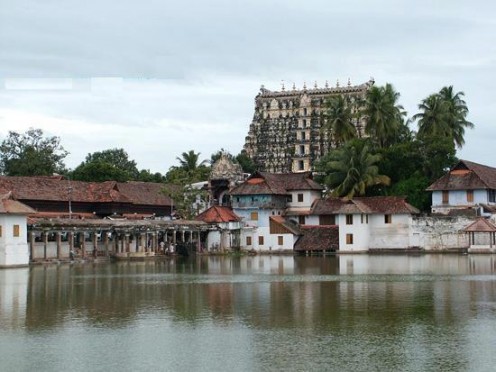
Padmanabhaswamy temple (aka Sri Padmanabhaswamy temple),is a famous Hindu temple of Lord Vishnu, located inside the East Fort in city of Thiruvananthapuram, Kerala, India. The temple is one of the 108 divya desam, the holiest abodes of Lord Vishnu and the main deity, Padmanabhaswamy is a form of Vishnu in Anananthasayanam posture (in eternal sleep of yognidra). This is an ancient temple and the city of Thiruvananthapuram derives its name from the name of the presiding deity enshrined in the temple. History
King Marthanda Varma, Maharaja of the erstwhile princely state of Travancore, did the last major renovation. He dedicated his kingdom to the deity, and pledged that he and his descendants would serve the kingdom as Padmanabha Dasa, meaning "servants of the Lord Padmanabha". With this, Sri Padmanabha became the nominal head of the state of Travancore, assuming the title Perumal, the Emperor. The British Government saluted the Lord with 21-gun salute, a military tradition of colonial days, which was continued by the Indian Army until the abolition of the privy purses by Government of India with Indira Gandhi as the Prime Minister. The royal insignia of the Lord, The Valampiri Shankhu or sinistral conch-shell, served as the State emblem of Travancore and even continued so for some time after the re-organisation of the States. Sri Padmanabha is still regarded as regional deity of Travancore[citation needed]. The two annual festivals of the Temple culminates with a grand procession, with the three deities (Sree Padmanabha, Narasimha Swamy and Krishna) carried on flower-decked and aesthetically decorated Garuda Vahanas to the Shankhumukhom beach, for 'aaraattu' (sacramental ablution). The 'aarattu' days are declared as local public holidays in Thiruvanathapuram.Sabarimala Temple
Location: Sahya hilly regions, Pathanamthitta District
State: Kerala
Principle Deity: Lord Ayyappa
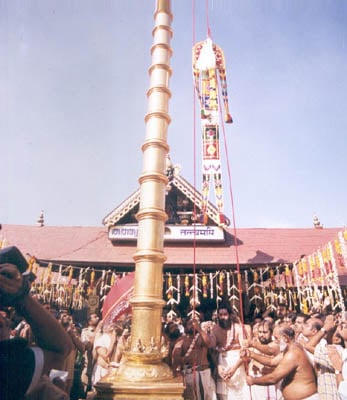
Raja of Pandalam constructed the Ayyappa temple at Sabarimala based on the advise of Lord. It is also believed that there already existed the DharmaSastha temple at Sabarimala, one of the 64 temples established by Parasurama, and Lord Ayyappa merged into the deity there. The King (Raja) of Pandalam renovated/ reconstructed the temple, supervising the work by staying at Perunadu. He constructed an Ayyappa temple there also for performing his daily pooja of the Lord. Deities of Malikappurathamma, Kadutha swami and Vaver swami were installed as also the 'pathinettampadi' (holy 18 steps) and 'bhasmakulam'. The legend behind Malikappurathamma is that Leela, daughter of Galavamuni, under curse of her husband Dathan, was reborn as Mahishi, an "asura' female with a buffalo's face. Upon having killed by Lord Ayyappa, the curse was revoked and the beautiful woman rose out of the corpse. She thanked the Lord and prayed to be with Him as His wife. However, the Lord told her that He is a 'brahmachari' and so her desire would not be fulfilled. However, He allowed her to remain in Sabarimala, a little distant from His abode, as His sister - Malikappurathamma. The Vaver temple at Erumeli, the beginning of the forest route was also constructed. Various rituals were fixed, believed to be on the advice of Agasthyamuni. Legend also says that Parasurama himself came down to install the Ayyappa deity. The 'vrutham' and other practices to be followed before and during the Sabarimala pilgrimage were also prescribed as dictated by the Lord. Arrangements for monthly poojas were made.
Once in a year, during Makaravilakku, the Raja visits Sabarimala along with the holy ornaments (Thiruvabharanam) from the Palace, which are, adorned on the Ayyappa deity and 'deeparadhana' conducted. It is at this time that the 'jyothi' appears on the eastern horizon. During Mandalam-Makaravilakku season, by custom, nobody starts on pilgrimage after the Raja of Pandalam sets out for Sannidhanam on 28th Dhanu, along with the Thiruvabharanam. In addition, pilgrims are restrained from going to Malikappuram after the 'guruthi' there on 6th Makaram.
The period of Ayyappa is considered to be somewhere between 300-400 M.E. (1125-1225 A.D). Since Pandalam was assumed by Travancore in 1820 A.D, the administration of all the temples within the kingdom, including Sabarimala was done by Travancore govt., which was subsequently handed over to the Travancore Devaswom Board after Independence. As per the Travancore State Manual " the understanding arrived at when the particular temples were founded and endowed are followed". Thus the Raja of Pandalam even now continues to function in the dual status of the father of the Lord and the founder of the temple.
The important pilgrimage season in Sabarimala is from 1st Vrischikom to 6th Makaram M.E. (mid-November to mid-January). Devotees irrespective of religion, cast, creed, nationality or social status are equals in His abode and are all addressed by His own name, namely 'Ayyappa'. In fact, the pilgrimage includes worship at Vaver temples at Erumeli and Sannidhanam, managed by Muslims. This stands as a glittering example of Hindu-Muslim unity. However, women in the age group 10-50 shall not go to Sabarimala. Other women devotees are permitted to trek the hill and are called as 'Malikappurams'.
Tirumala Sri Venkateswara Temple
Location: Tirupati
State: AndhraPradesh
Principle Deity: Sri Venkateswara(Lord Vishnu)
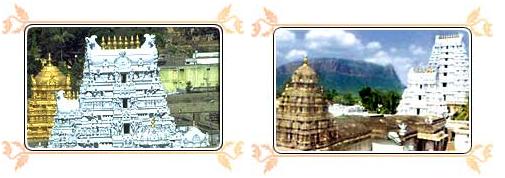
The ancient and sacred temple of Sri Venkateswara is located on the seventh peak, Venkatachala (Venkata Hill) of the Tirupati Hill, and lies on the southern banks of Sri Swami Pushkarini.It is by the Lord's presidency over Venkatachala, that He has received the appellation, Venkateswara (Lord of the Venkata Hill). He is also called the Lord of the Seven Hills.
The temple of Sri Venkateswara has acquired unique sanctity in Indian religious lore. The Sastras, Puranas, Sthala Mahatyams and Alwar hymns unequivocally declare that, in the Kali Yuga, one can attain mukti, only by worshipping Venkata Nayaka or Sri Venkateswara.
The benefits acquired by a pilgrimage to Venkatachala are mentioned in the Rig Veda and Asthadasa Puranas. In these epics, Sri Venkateswara is described as the great bestowed of boons. There are several legends associated with the manifestation of the Lord at Tirumala.
History There is ample literary and epigraphic testimony to the antiquity of the temple of Lord Sri Venkateswara. All the great dynasties of rulers of the southern peninsula have paid homage to Lord Sri Venkateswara in this ancient shrine. The Pallavas of Kancheepuram (9th century AD), the Cholas of Thanjavur (a century later), the Pandyas of Madurai, and the kings and chieftains of Vijayanagar (14th - 15th century AD) were devotees of the Lord and they competed with one another in endowing the temple with rich offerings and contributions. It was during the rule of the Vijayanagar dynasty that the contributions to the temple increased. Sri Krishnadevaraya had statues of himself and his consorts installed at the portals of the temple, and these statues can be seen to this day. There is also a statue of Venkatapati Raya in the main temple.
Temple Legends Sri Venkatachala Mahatmya is referred to in several Puranas, of which the most important are the Varaha Purana and the Bhavishyottara Purana. The printed work contains extracts from the Varaha Purana, Padma Purana, Garuda Purana, Brahmanda Purana, Markandeya Purana, Harivamsa, Vamana Purana, Brahma Purana, Brahmottara Purana, Aditya Purana, Skanda Purana and Bhavishyottara Purana. Most of these extracts describe the sanctity and antiquity of the hills around Tirumala and the numerous teerthams situated on them. The legends taken from the Venkatachala Mahatmya and the Varaha Purana, pertaining to the manifestation of the Lord at Tirumala, are of particular interest. According to the Varaha Purana, Adi Varaha manifested Himself on the western bank of the Swami Pushkarini, while Vishnu in the form of Venkateswara came to reside on the southern bank of the Swami Pushkarini.
Pilgrimage Attractions at Tirupati Tirumala
Padi Kavali Maha Dwara The Padi Kavali Maha Dwara or Outer Gopuram stands on a quadrangular base. Its architecture is that of the later Chola period. The inscriptions on the gopuram belong to 13th century. There are a number of stucco figures of Vaishnava gods like Hanuman, Kevale Narasimha and Lakshmi Narasimha on the gopuram.
Sampangi Pradakshinam The path for circumnavigating the temple is called a pradakshinam. The main temple has three prakarams. Between the outermost and middle prakarams is the second pathway for circumambulation known as the Sampangi Pradakshinam. Currently, this pathway is closed to pilgrims. The Sampangi Pradakshinam contains several interesting mandapams like the Pratima Mandapam, Ranga Mandapam, Tirumala Raya Mandapam, Saluva Narasimha Mandapam, Aina Mahal and Dhvajasthambha Mandapam.
Ranga Mandapam Ranga Mandapam, also called the Ranganayakula Mandapam, is located in the south-eastern corner of the Sampangi Pradakshinam. The shrine within it is believed to be the place where the utsava murti of Lord Ranganadha of Srirangam was kept during the 14th century, when Srirangam was occupied by Muslim rulers. It is said to have been constructed between 1320 and 1360 AD by the Yadava ruler Sri Ranganadha Yadava Raya. It is constructed according to the Vijayanagara style of architecture.
Tirumala Raya Mandapam Adjoining the Ranga Mandapam on the western side, and facing the Dhvajasthambha Mandapam is a spacious complex of pavilions known as the Tirumala Raya Mandapam or Anna Unjal Mandapam. It consists of two different levels, the front at a lower level and the rear at a higher. The southern or inner portion of this Mandapam was constructed by Saluva Narasimha in 1473 AD to celebrate a festival for Sri Venkateswara called Anna Unjal Tirunal. This structure was extended to its present size by Araviti Bukkaraya Ramaraja, Sriranga Raja and Tirumala Raja. It is in this Mandapam, that the utsava murthi Malayappan, holds His annual darbar or Asthanam during the hoisting of the Garudadhwaja on Dhwajastambham to mark the commencement of Brahmotsavam. Incidentally, the prasadam distributed on this occasion is still called Tirumalarayan Pongal.
Tirumala Raya Mandapam The Mandapam has a typical complex of pillars in the Vijayanagara style, with a central pillar surrounded by smaller pillars, some of which emit musical notes when struck with a stone. The main pillars have rearing horses with warriors mounted on them. Some of the best sculptures of the temple are found in bold relief in the Mandapam. The bronze statues of Todermallu, his mother Matha Mohana Devi and wife Pitha Bibi, are kept in a corner of the Mandapam.
The Aina Mahal The Aina Mahal is on the northern side of the Tirumala Raya Mandapam. It consists of two parts - an open mandapam in the front consisting of six rows comprising six pillars each, and a shrine behind it consisting of an Antarala and Garbhagriha. It has large mirrors which reflect images in an infinite series. There is an unjal in the middle of the room in which the Lord is seated and festivals conducted.
The Daily Routines - Tirupati Tirumala Balaji Temple The daily program starts with 'Suprabhatam' (awakening the Lord) at three in the morning and end with the 'Ekanta Seva' (putting the Lord to sleep) at one in the night. Daily, Weekly and Periodical 'Sevas' and 'Utsavams' are performed to the Lord. Interested pilgrims can choose from the list and pay to get the Sevas or Utsavams done on their name. Devotees offer their gifts and donations in the "Hundi", which is the main source of income. Festivals of Tirupati Everyday is a day of festivity at Tirumala. The most famous is the annual festival called 'Brahmotsavam', which is celebrated on grand scale for nine days in September, attracting pilgrims and tourists from all parts of the country. The fifth and ninth days of the festival are especially significant in as much as Garudostavam and Rathotavam takes place on those days.
Bull Temple
Location: Mysore
State: Karnataka
Principle Deity: Nandi(celestial bull)
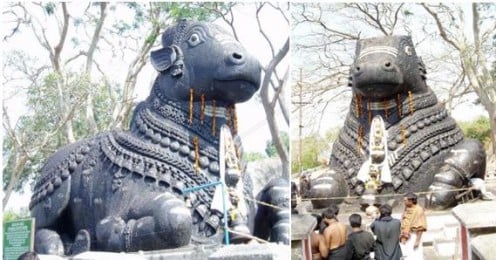
The Bull temple of Mysore is located in the Southern part of India in the state of Karnataka. It was constructed in the 6th century and is dedicated to Nandi, the sacred bull of Lord Shiva. The Structure of the holy bull is carved out of a single block of Granite rock. The temple reflects the specimen of the Dravidian architecture. The Gigantic bull measure 4.57 meters in height and 6.10 meters in length. The temple houses Nandi the Vahana or vehicle of Shiva, along with sculptures of God Surya and goddess Candra on their chariots drawn by horses. Also there is a small lingam shrine bedecked with the exquisite Gopuram. The Bull temple, Mysore comes to liveliness during the Shivratri festival.
Chamundeswari Temple
Location: Mysore
State: Karnataka
Principle Deity: Chamundeswari (Lordess Durga)
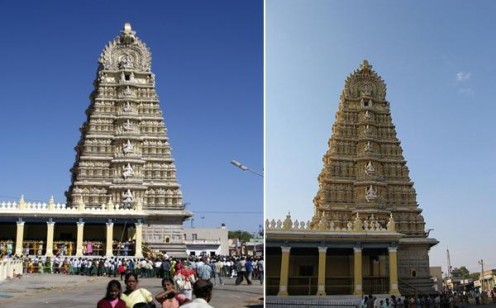
Chamundeswari Temple is located on the top of Chamundi Hills about 13 km from the palace city of Mysore in the state of Karnataka in India. The temple was named after Chamundeswari or Durga, the fierce form of Shakti, a tutelary deity held in reverence for centuries by Mysore Maharajas.
The original shrine is thought to have been built in the 12th century by Hoysala rulers while its tower was probably built by the Vijayanagar rulers of the 17th century. In 1659, a flight of one thousand steps was built leading up to the 3000 foot summit of the hill.
At the temple are several images of Nandi (the bull mount of Shiva). There is a huge granite Nandi on the 800th step on the hill in front of a small Shiva temple a short distance away. This Nandi is over 15 feet high, and 24 feet long and around its neck are exquisite bells.
The temple has a seven story tall 'gopuram' decorated with intricate carvings. The idol of the Chamunda Devi is said to be made of solid gold and the temple gates are made of silver.
Ekambaranathar Temple
Location: Kanchipuram
State:TamilNadu
Principle Deity: Ekambaranathar(Lord Shiva)
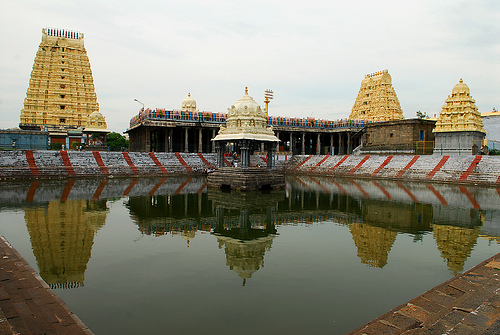
Ekambaranathar Temple is one of the oldest temples in the city. The architecture of this temple is amazing. The gopuram of this temple stands as a massive landmark, spanning a height of 57 metres - one of the tallest in South India. The vast temple premises introduce you to many wonders, one after another.
The first is the "Aayiram Kaal Mandapam" or the hallway with a thousand pillars. The next is the array of 1008 Siva Lingams that decorate the inner walls of the temple. The most important, of course, is the "sthala-virutcham", a 3500 year old mango tree whose branches give four different types of mangoes. This temple bears the work of practically every dynasty which ruled Kanchipuram.
This temple, unlike the Kailasanathar temple, lies right in the middle of the busiest intersection in the city and is filled with people almost all the time. It is located diagonally opposite to the Sankara Mutt. It will be extremely crowded on Sivaraathri.
According to legend, this temple is located around the 3500 year old mango tree. Hindu mythology says that Kamakshi Amman performed a penance here under the mango tree to get married to Lord Shiva. In Sanskrit, "Eka" means One, and "Amaram" means "Mango Tree". Hence, Ekambaram literally means "One Mango Tree".
Because of its age and vastness, not all places in the temple are accessible to Tourists. Some places can be accessed with special permission.
Recently, this temple hit the news owing to the visit of Queen Elizabeth in October 97, to see the 3500 year old mango tree and the weaving of Silk Sarees in handlooms. Silk Sarees of Kanchipuram have apparently been one the the Queen's favorites for a very long time.
Brihadisvara Temple
Location: Thanjavur
State:TamilNadu
Principle Deity: Brihadeeswarar (Lord Shiva)
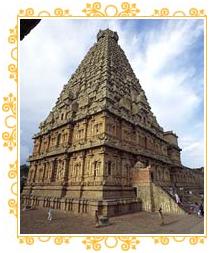
Thanjavur became a center of learning during 10th to 14th century AD. The Brihadeeswara temple is the major center of tourist attraction at Thanjavur. Thanjavur is the ancient capital of the Chola kings. King Rajaraja Chola constructed the Brihadeeswara Temple in 10th century AD and the architect Sama Varma designed it. The Cholas were great patrons of art. During their reign, the most magnificent temples as well as exquisite bronze icons were created in south India. Sama Varma designed a unique structure because no shadows of the temple were cast on the ground at any time of the year. It is symbolic of the fact that the Supreme is considered to be there and yet not there. The temple is the finest contribution of the Chola dynasty to the Dravidian style of temple architecture.
The Brihadeeswara temple is within a huge compound with walls rising above 15m. The temple is made over a 29 m square base and has a soaring vimana and a stunted gopuram. The inner sanctum and the gopuram were constructed over a period of 12 years. It was constructed from a single piece of granite weighing around 80 tonnes. The dome was hauled into place along a 4-km earthwork ramp in a manner similar to the Egyptian pyramids. The lofty sanctum tower known as the Srivimana, is enclosed by a rectangular prakara or corridor consisting of two squares. The main tower occupies the center part of the rear square, with the center vimana or tower having 16 tiers, which rises to a height of 200 ft. The tower is considered to be symbolic of the mountain Meru. The inscriptions on the walls of the vimana record the contributions of Rajaraja Chola and his sister. Several stucco features also decorate the vimana.
Ramanatha Swamy Temple
Location: Rameshwaram
State: Tamilnadu
Principle Deity: Sri Ramanatha Swamy(Lord Shiva)

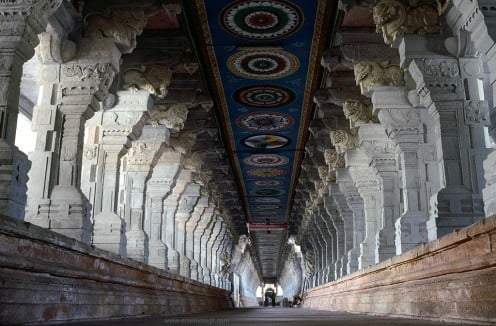
This Shivastalam is considered to be one of the holiest shrines in India. It represents the southernmost of the 12 Jyotirlingams of India and has been a time honored pilgirmage center held on par with Banaras. The island-temple town is located off of the Sethu coast of Tamilnadu (south eastern). This shrine is regarded as the 8th of the Tevara Stalams in the Pandya region of Tamilnadu.
This temple is assocated closely with the Ramayana and Rama's victorious return from Sri Lanka.
Rameswaram is an interesting temple both from the standpoint of its association with Rama and from a structural standpoint. A. huge temple in the island of Rameswaram (reached via the Pamban bridge across the sea), Rameswaram is known for its long ornate corridors and towers and 36 theerthams.
Legend has it that Rama worshipped Shiva in the form of a Shiva Lingam made of earth by Sita, while returning to Ayodhya. Legend has it that Hanuman was entrusted with the task of bringing an image of Viswanathar from Benares. Anticipating delay in Hanuman's return from Benares, Rama is said to have offered worship at a pre-chosen auspicious moment to a Shivalingam fashioned out of earth by Sita. This lingam is referred to as Ramalingam and the town is known as Rameswaram.
There is yet another Shivalingam here - Viswanathar said to have been brought by Hanuman from Banares. This Shivalingam is referred to as Kasilingam and Hanumalingam. Prayers are offered to Viswanathar before they are offered to Ramanathaswamy.
Shore Temple
Location: Mahabalipuram
State: TamilNadu
Principle Deity: Lord Shiva
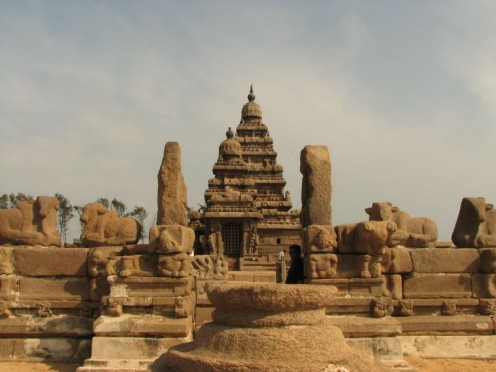
It is believed that there were seven magnificent temples what are known as the seven pagodas, built near the sea share. But the lonely survivor is the shore temples. It was originally constructed during the 7th century and later it was Narasimha Varman II, (Rajasimha) completed the skilled work in his rule. This is one of the oldest of the south Indian Temples which were structural temples constructed in the nature Dravidian style. This shore temple has gained popularity and tourists gather here because it has been listed among the world heritage sites of the UNESCO. The temple is full of designs made by carvings.
There are three temples of which two Shiva Temples face east and west respectively. The other one is the Vishnu Temple. The Vishnu temples were built by Narasimha Varman I and the other two were built by Narasimha Varman II. One can find the beautifully carved twin Dwarka Palaks (gate keepers) at the entrance of the east facing Shiva Temples. On both sides of the temple inside are the marvelous sculptures of Lord Brahma and Lord Vishnu with their better halves. The top part of the Shivalinga figure inside the temple is found damaged. There are sculptures of Somaskanda - lord Shiva with his better half, Parvati, and his sons, Skanda and Ganesha are found on the near wall. Apart from Lord Shiva’s sculpture, one can find the sculptures of Narasimha and Goddess Durgha also.
The central shrine is in the form of a rectangle. It has a magnificent statue of lord Vishnu which is known as Sthala Shayana Perumal or Ananthasayana which means sleeping Vishnu. The peculiarity about this particular temple is - Vishnu reclines on the floor listening silently the sounds of names. The figure of Vishnu is found in segments which are to be looked through various doors. The other sculpture is portrayed in such a may that Lord Vishnu seated in mount Garuda helping Gajendra, the elephant, found in the southern wall and the northern wall is the portrayals from the life of lord Krishna. The grand temple is surrounded by mandapas and compound walls. There is a rock-cut of a lion rode by two young women. The lion has a small cut, a square shaped cut in its belly. A Huge rock near by the temple has been the target of the waves to touch it from the ancient days. There is also a carving of a buffalo demon running with a stick in his hand, located in the northern side. The temple looks beautiful due to the lights during weekend evenings.

